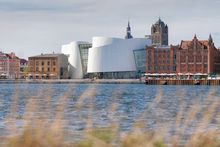 25 Jan 2025
25 Jan 2025
Tags: Ozeaneum, Ocean, exhibitions, aquariums, Northern Sea, Baltic Sea

On 11 July 2008, former Federal Chancellor Angela Merkel opened the OZEANEUM on Stralsund's harbour island, the largest new museum building funded by the federal government at that time. The spectacular building, designed by Behnisch Architekten, gave the harbour panorama of the UNESCO World Heritage City a clear, contemporary accent. With over half a million visitors a year, the OZEANEUM has become a first-class visitor magnet. In May 2010, it was awarded "Europe's Museum of the Year" and in September 2022, the directors welcomed the eight millionth guest since its opening.
The building’s structure is made up of four amorphously formed building complexes that resemble rocks being washed around by the sea. Each complex is connected by one light-flooded foyer made of glass. When entering the building, three original whale skeletons already catch the visitor’s eye. An unsupported escalator leads to the exhibition areas. It is 34 metres long – as long as a blue whale. About 50 partly huge sea water aquaria will take the visitor on a unique journey through the underwater world of the northern seas. The discovery tour starts with Stralsund’s harbour basin in the Baltic Sea aquarium. All the way through bodden waters and eelgrass meadows, past the chalk coast and across Scandinavia’s Archipelago Sea, the visitors experience the diverse local flora and fauna.
The biggest fish on display on the Baltic Sea tour are sturgeons which are shown in their natural habitat – the mouth of a river. In the spring of 2013, OZEANEUM’s aquarists succeeded in breeding common jellyfish for the first time. Since then, these fascinating beauties can be marvelled at independent of the seasons in the Baltic Sea exhibition.
The tanks of the North Sea aquarium show the biosphere of the North Sea and the North Atlantic. An elaborately designed tunnel aquarium is dedicated to Heligoland, Germany’s only rocky island. OZEANEUM’s largest tank contains 2.6 million litres of water. It is part of the “Open Atlantic” display and is home to schools of mackerel, two nurse sharks and various species of rays. Two 20-ton acrylic panes, each 30 centimetres thick, provide an 80-square-metres panoramic view on two levels.
Since 2015, specially built aquaria display cold water corals. In front of and behind the scenes, more than 4 million litres of water permanently rush through the aquaria’s water circulation systems. The initial filling of the tanks required 150 tons of salt. According to the exhibition organisers’ concept, the aquaria are the living completion of all five exhibitions and their numerous original and rare pieces put on display such as various self-made zoological and botanical preserved specimens. OZEANEUM also presents Europe’s biggest Baltic Sea exhibition including a plankton installation, a Baltic Sea relief to touch and elaborately arranged typical living environments displayed in large, triangular showcases.
A permanent exhibition on the “Exploration and Utilisation of the Sea” as conceived by the German Marine Research Consortium, the World Wide Fund for Nature and other partners was opened in July 2011. Among others, it involves a deep-sea diving trip, shows original exhibits and focuses on aspects of German marine research as well as overfishing and methods of sustainable fishing.
Further expositions show the biodiversity of the world oceans or feature a more hands-on approach to marine life for children at the Children’s Sea area, which was completely redone in 2017. One of the main attractions is the Humboldt penguins on the museum’s roof terrace. These agile feathered swimmers can be observed through large windows. Visitors may witness the daily commented penguin feeding at 2 pm and enjoy a unique view of Stralsund’s old town from a height of 14 metres at the same time. Dr. Angela Merkel, bestselling author Frank Schätzing and other supporters took on animal sponsorships for these endangered animals.
The tour ends in the impressive exhibition "1:1 Giants of the Seas", which was created in cooperation with the environmental protection organisation Greenpeace. Full-size replicas of whales and other sea giants float across the entire height of the room. The largest exhibit is a blue whale with a length of 26 metres. Also on display are a diving sperm whale fighting a giant squid, a killer whale and a humpback whale with its young. The dramatic highlights are the songs of the humpback whale and the clicks of the sperm whales, which they use to track down their prey at depths of up to 3000 metres. A multimedia presentation also provides information about whales, their endangerment and protection options.
OZEANEUM is certified as family-friendly by the Mecklenburg-West Pomeranian tourist association and barrier-free by the German seminar for tourism.


